
Fair warning … what you’re about to experience is the least sexy guide to Facebook ad campaigns ever produced.
Sure, there’ll be plenty of beautiful and high-performing ad examples later on but that’s not where we’ll start.
Instead, this guide will major on how to manage campaigns through a consolidated account structure designed for ecommerce growth.
Why?
Because when your account structure isn’t optimized:
- Your ads won’t exit the learning phase
- Your budgets won’t spend evenly
- Your ROAS won’t hit its target
Or, they will. And you’ll be plagued by manic swings in performance under the lash of relentless manual tinkering.
It’s time to hit the reset button.
You won’t get sizzle, pop, or flash. Instead, you’ll get something better. Step-by-step guidance on how to …
Apply this consolidated structure to grow your Facebook ads profitably and restore your paid-media sanity.
Before we jump in, three things …
First, the big picture.
The Facebook Consolidated Account Structure is a framework for organizing your campaigns, ad sets, and ads.
There are plenty of approaches based on your AOV, your CPA target, or how many products you have.
Here’s what the basic structure — the blueprint — looks like, which can be adapted and expanded:
Second, the tool.
To make this actionable, we’ve created a Google Sheet you can download and make your own.
On the first tab of the tool, you’ll see the Ad Set Calculator to determine how many ad sets (as a rule of thumb) you should be running based on your daily budget and current CPA.
We’ll reference this Sheet throughout.

Third, the goal.
At Common Thread Collective, we require all our buyers to spend at least 30% of a client’s budget beyond the learning phase.
Why? Because you always want to spend money against optimized outcomes. Not in the process of generating optimized outcomes.
Facebook needs ~50 conversions per week to optimize an ad set properly; therefore, your maximum number of ad sets within any given campaign must be determined by …
Organizing Your Facebook Ads Manager: Beyond Campaign Objectives & Ad Formats
There are three ways you can organize the consolidated account structure to plan and execute campaigns:
- SKU
- Offer
- Audience
In case you’re wondering: yes, you can mix and match to make them fit your business (as long as you have the budget to do so).
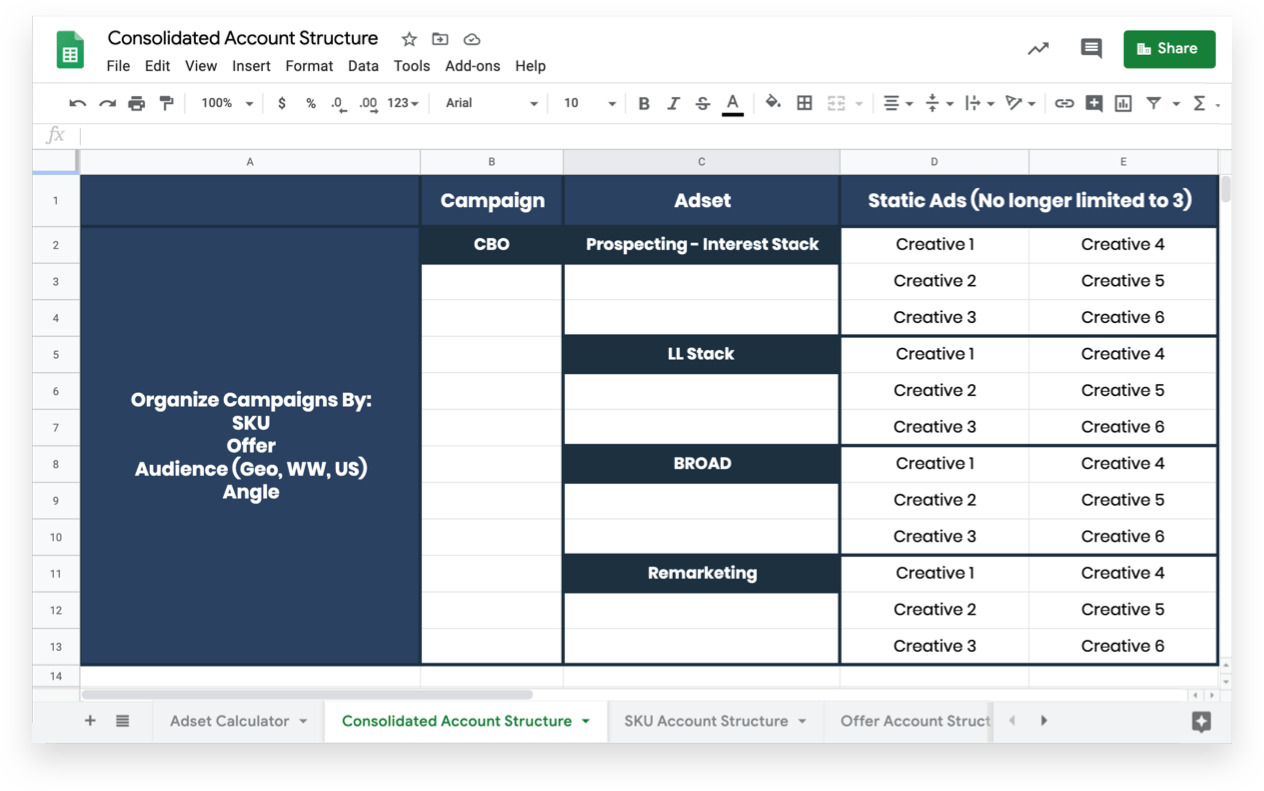
1. SKU-Based Facebook Advertising Campaigns
Organizing your campaigns by SKU gives you a clear idea of what products are most profitable. It’s ideal for brands that have at least three or more primary SKUs.
If you have a lot of SKUs that vary in AOVs, you don’t have to organize campaigns by each and every product. Rather, it can be a collection or product grouping.

If you’re running with a limited budget, select your top-selling products that offer the optimal brand experience or work well in prospecting.
2. Offer-Based Facebook Advertising Campaigns
In the big picture, offer doesn’t mean discount. Nor does it simply mean promotion. Instead, offer refers to the sum total of your …
- Product(s)
- Price
- Positioning
In your account structure, offer campaigns can separate special events, special sales, or special angles.
Say you’re selling a Collagen product with multiple benefits; it helps with your skin, hair, and joints.
Using the offer account structure you can run multiple campaigns, tailor the offer or angle to different audiences, and set up different landers to explain the specific benefits.
The same goes for running seasonal promotions like Mother’s Day, Father’s Day, and Black Friday, Cyber Monday campaigns.
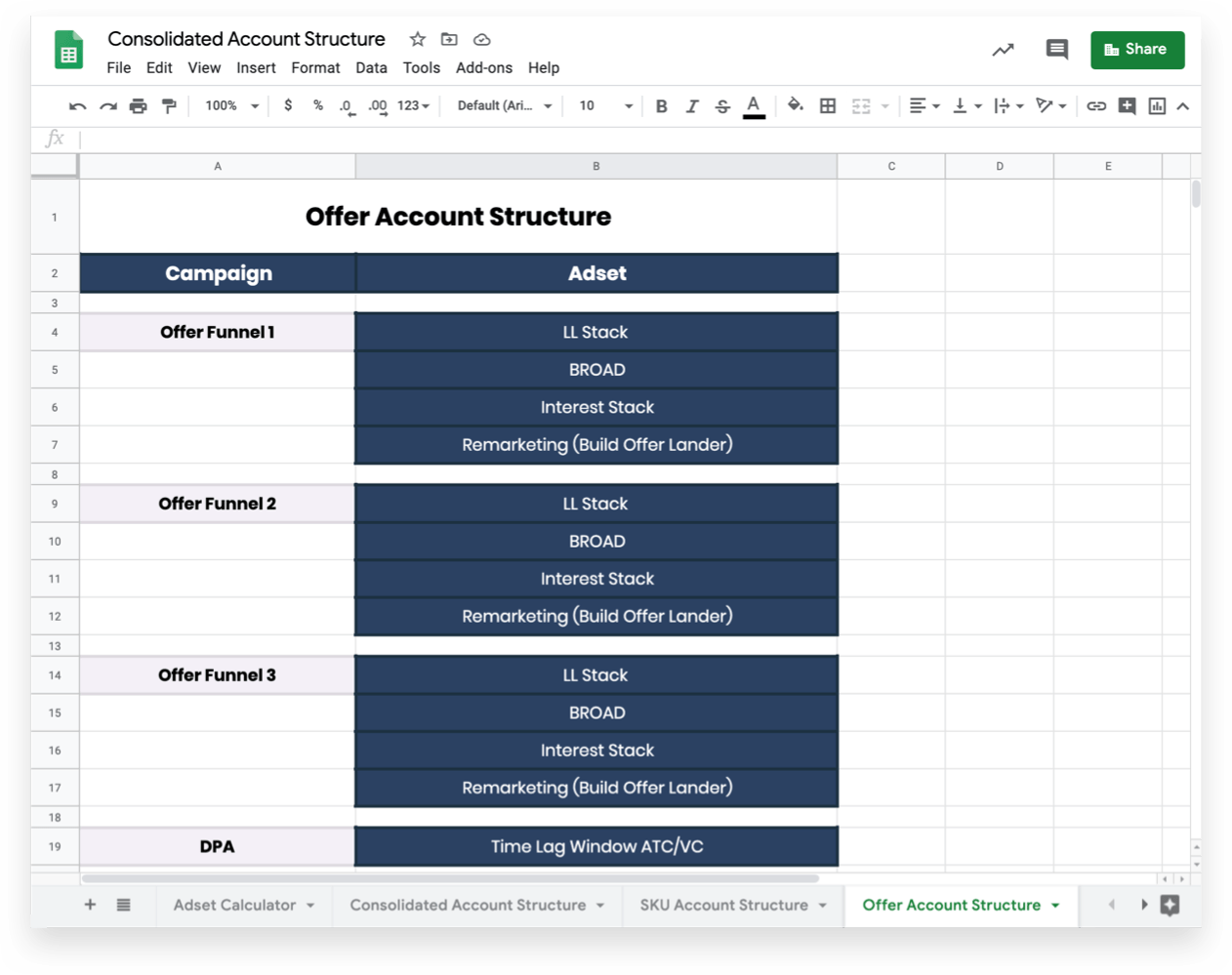
3. Audience-Based Facebook Advertising Campaigns
The audience account structure is ideal for brands with sales funnels or sites unique to geographic locations.
To be clear, this isn’t referring to Lookalike Audiences (LL) or targeting custom audiences around interests.
It’s based on targeting specific countries.
It moves away from splitting out a bunch of audience CBOs where you might have Interest CBO 1 with a variety of interests and pivoting towards stacks.
Instead, build LLs but have a funnel for each country you’re targeting.
Depending on your budget, you might want to start with a Tier 1 funnel that includes the main countries you’re targeting and then a catch-all worldwide funnel (if you sell globally) that excludes the Tier 1 countries you’ve set up.
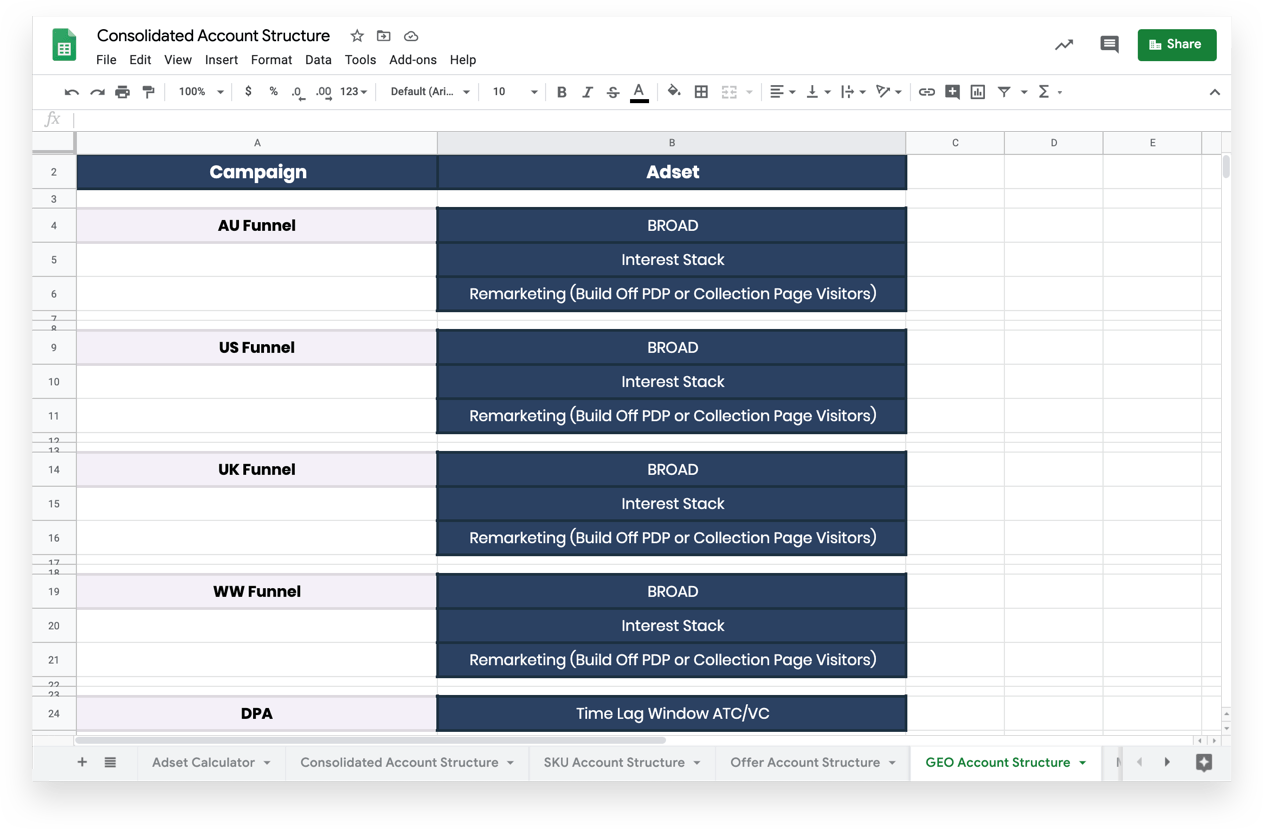
Mix & Match Account Structure
There are plenty of ways to mix and match your campaign structure to fit your business. A lot of our accounts at Common Thread Collective have one-off offer funnels depending on the time of the year, a few geographic (audience) funnels, and then evergreen SKU funnels.
No matter how you choose to structure yours … always go back to the ad set calculator to help you start with a set-up that makes sense with your budget.
Focus your budget on the lowest number of ad sets possible — fewer sets mean faster learning — to make sure your ads are optimizing properly.
Sorting Ad Sets by Target Audience
The consolidated ad structure looks at four different stacks:
- Lookalike Audiences
- Broad
- Interest Stack
- Remarketing
Lookalike Audiences
For ad sets, LLs shine when you’re running product funnels and offers. So, begin by using the following Facebook or email lists:
- Customers who bought that particular product
- Engagers who interacted with an ad for that product
- Website visitors who clicked through but didn’t buy from that PDP
Then you can build in your Broad and interest stacks later.
Broad
Going Broad works well for products with a big demographic and wide appeal. The Facebook Pixel will go find those people for you; it’s like a trained hunting dog.
Of course, if you haven’t trained it yet, it can’t go find the data you’re looking for. Wait until you reach 500-1000 purchases before using Broad.
Only in the rarest of instances should you set campaign objectives to brand awareness. Instead, you want your Facebook Pixel trained for purchases — even if you’re focused on brand awareness — so that it optimizes and learns for conversions.
Interest Stack
Stack all of your Interests together, rather than splitting them out for your prospecting campaigns.
Why? We don’t know how Facebook decides who goes into these audiences. So consolidate all your Interest audiences into one ad set and focus on the specific ad creatives instead.
Only separate Interests if your ads drive directly to custom landing pages built with specific Interests in mind.
Even then, you might just want to separate those two interests into two separate campaigns to monitor the LTV for these specific audiences.
Remarketing
Although it may sound counterintuitive, housing the bulk of your remarketing within full-funnel campaigns is crucial. Not only for better data but also for better reporting and spend allocation.
If you’re selling lotion, you want to ensure the remarketing for that lotion SKU is in that same campaign so you can look at the data as a whole.
The exception to this primarily surrounds special events and seasonal sales.
Running Limited Ads in Ad Sets
We can’t give you the magic number. As a best practice, stick with the 5-10 range.
The goal when using static ads is to build them out and trust Facebook to dictate where the budget is being spent, rather than making manual decisions on which ads to turn on and off.
Instead, rotate new ads into or remove old ads from existing campaigns.
If you’re getting spend on ads but you’re below performance, take a look at your cost caps. It’s rare to see bad spending when caps are set correctly.
Move away from trying to buy your way into performance.
Instead, think more about your creative, messaging, offers, landers, and angles — that’s where you’re going to win.
Applying the Consolidated Ad Structure to Your Own Campaigns
As a final point of strategy, let’s think through …
- What funnel set-up to pick?
- How many creatives to put in each ad set?
- And what the starting budget would be based on CPA targets?
Although ecommerce businesses differ in all sorts of ways, there are really only two types when it comes to Facebook set-up.
Type 1: Limited SKUs
If your AOV doesn’t vary, lean on product-specific or angle-specific funnels. When you’re thinking about testing different messaging, split them out within the ad set.

If you’re looking to test the messaging with different landers, that’s when you’d split it out to another campaign.
Type 2: Lots of SKUs
Dive into your account and see where you have good margin. It’s hard to push on products with bad margin.
Ask yourself:
- What gives people a good brand experience?
- What products do people like the most?
- What products are thumb stopping and easily translate into great creative?
Also think about where you are directing people and isolating these products into their own collection.
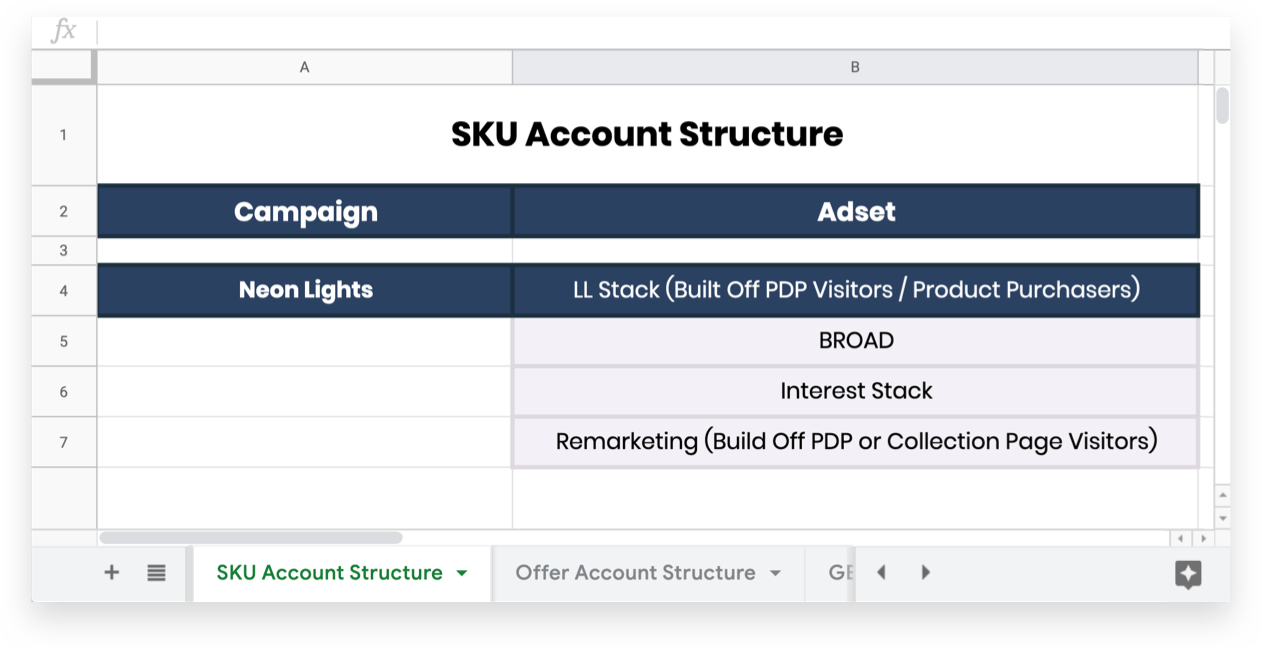
If you have a limited budget start with LL and remarketing ad sets. As you get more budget you can expand your ad sets to include a Broad and interest stack.
How do you make the switch? One campaign at a time, consolidating it over a week or two.
If you’re trying to move things over. Always leave your good stuff running and launch the new structure on the side. Make sure it’s working and performing.
If you’re worried about overspend or have a strict budget, kill bad spend and replace those first. Pull back budgets a little, introduce a new campaign, and then eliminate budget on the one you’re replacing.
Five Real Examples of Facebook Ad Campaigns & Ad Placements
We’ve covered the tactical set-up — now we’re going to take you through five client examples of different campaign types, what creative they used, and a breakdown of why the ads performed so well.
The campaign types we’ll be looking at:
- Full Funnel
- Prospecting
- Remarketing
- Audience (Geographic)
- Event
1. Full Funnel Campaign: Crown & Paw
It’s hard to go wrong when you’re using puppies in your creative. Then again, the Internet is flooded with all things cute.
Crown & Paw’s full-funnel campaign follows the consolidated ad structure — grouping prospecting and remarketing:

Given its high engagement rate in the mobile and desktop news feed, both of the creatives we’ll focus on use emotionally-charged video ads; namely, UGC showcasing happy customers receiving the portraits of their dogs.
In addition, they segue into footage of Humane Society International caring for dogs.
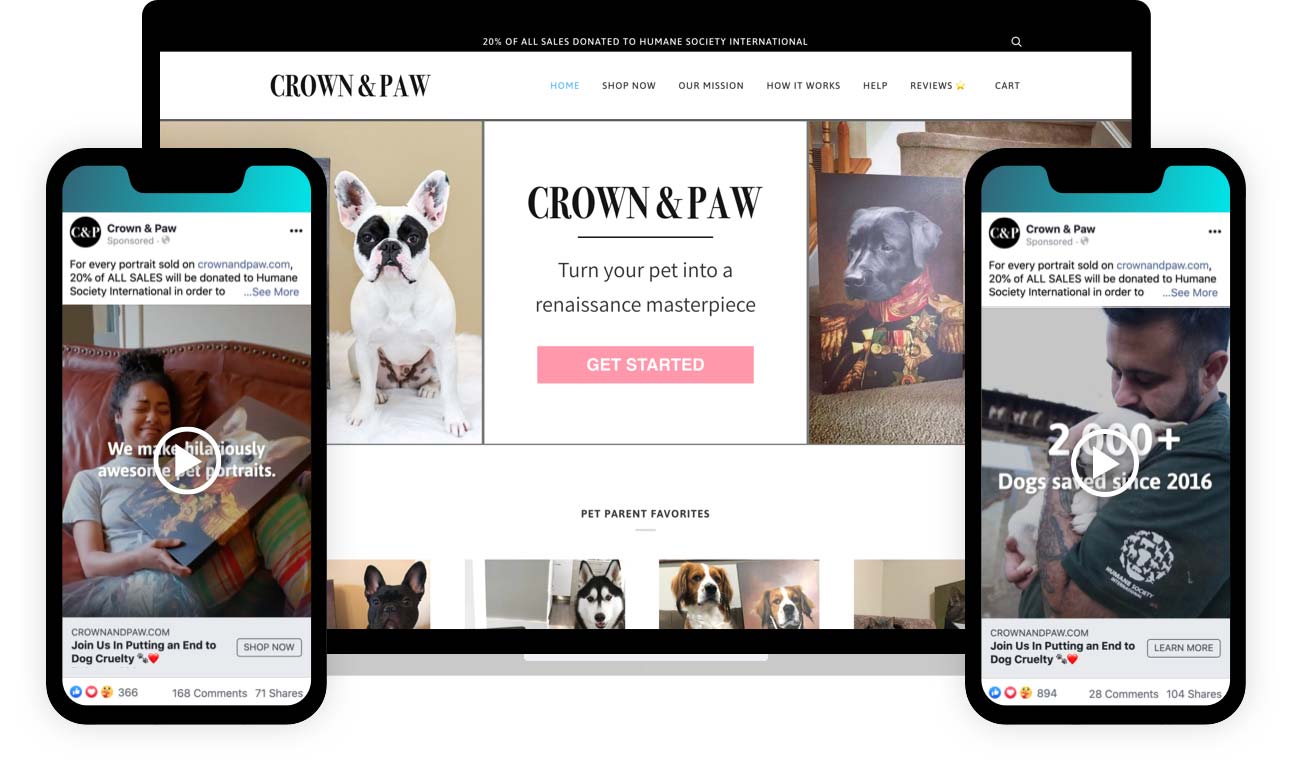
Within a few seconds, it’s clear how a prospect can make a difference in putting an end to dog cruelty.
For copy, prospecting leads with “We are Crown & Paw,” which is necessary when introducing the brand and what they do. Remarketing kicks off with “2000+ dogs saved since 2016” to further reinforce their mission.
Lastly, both ads drive traffic to the same landing page, which has a clear CTA to “Get Started.”
2. Prospecting Campaign: Alala
Using a combination of ad types — single-image ads, customer quotes, PR mentions, video ads, and more — Alala’s luxury athleisure prospecting centers on two audiences: Broad and a Lookalike (LL) Interest stack:
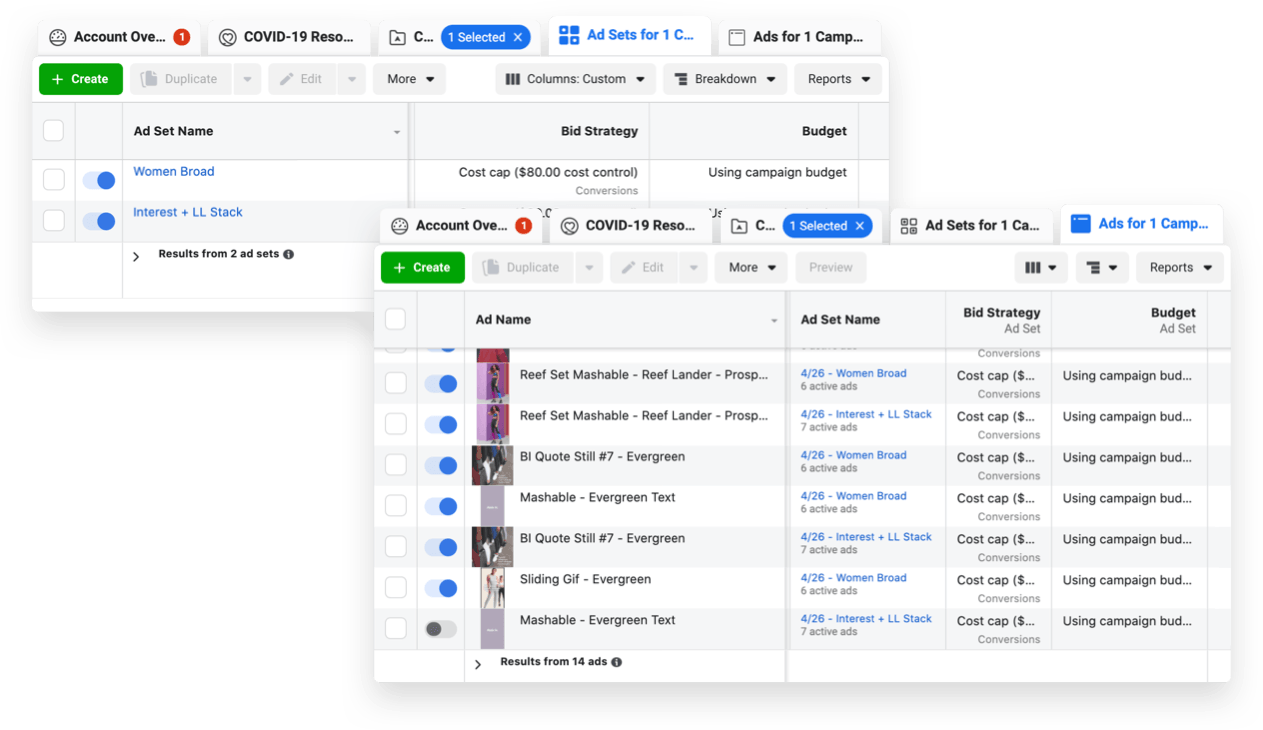
The two we’ll highlight feature a clear discount code that’s easy to remember and access, which is a quick win for making a good first impression.
For social proof, they leverage a quote from Business Insider in the creatives as well as the Facebook copy.
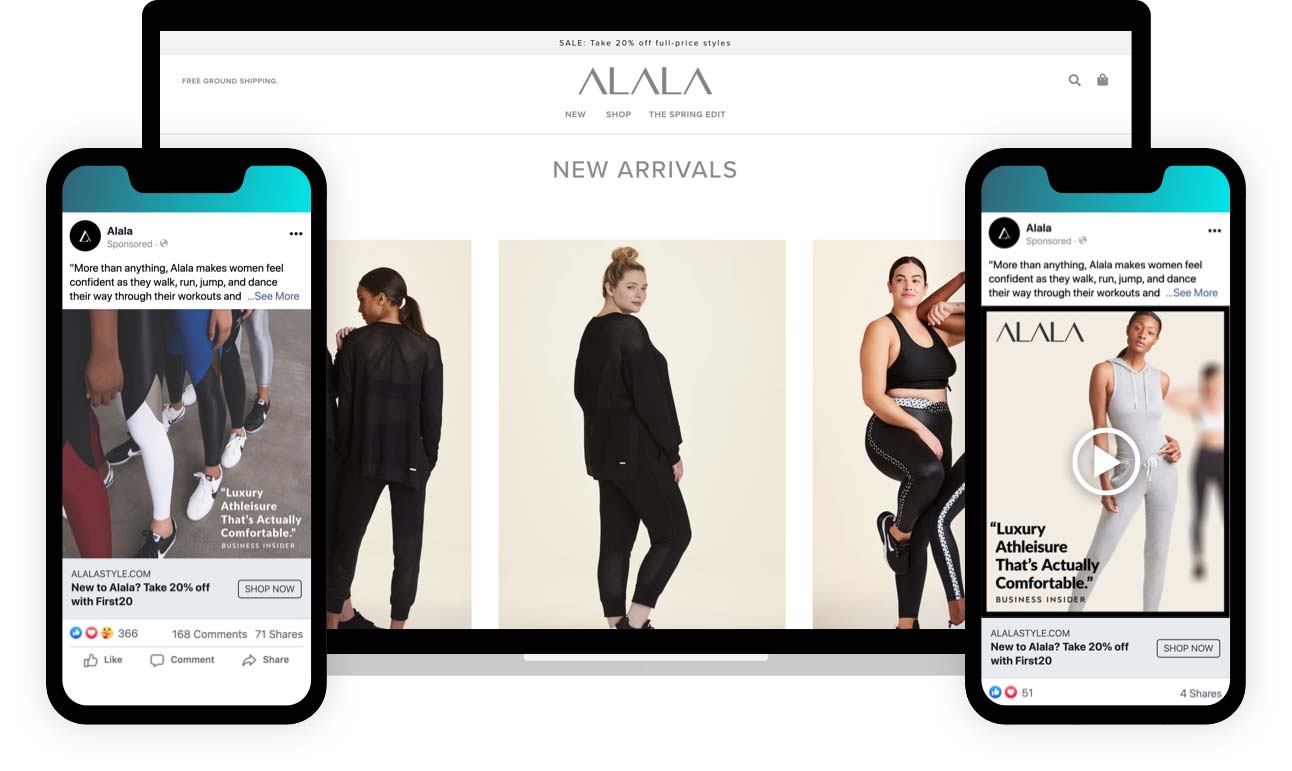
While the copy remains the same, they are testing a second ad creative with a sliding gif that showcases a number of the clothes.
The ad goes straight through to a landing page featuring their latest collection and new arrivals.
3. Remarketing Campaign: Fresh Clean Tees
To monitor and better control efficiency, Fresh Clean Tees separates its retargeting audiences by ad set: cart abandoners, social engagers, email users, and site visitors:

Here are three examples of those ads in action from the Facebook news feed …

Notice that while the ad creative varies, all three are more product-centric than the previous ads. The first and third feature videos, a customer testimonial, and a clear 15% promotion offer.
The second uses a carousel ad to highlight a different USP in each photo and showcase each color of the tee on a model. As long as your catalog sales are set-up for ecommerce, Dynamic Product Ads (DPAs) typically crush retargeting by automatically generating a slideshow of popular products.
4. International Campaign: Supply & Native
With more online retailers spreading their global wings, let’s examine two campaigns from two companies with one key difference: language.
Throughout last year, single-edge-razor brand Supply ramped up its global presence through a handful of campaigns by duplicating domestic ads, changing the targeting from US to worldwide, and setting language to English.
By the end of 2019, low costs and strong performance took international sales from nothing to 30% of Supply’s annual revenue — with $250k in Nov. alone:
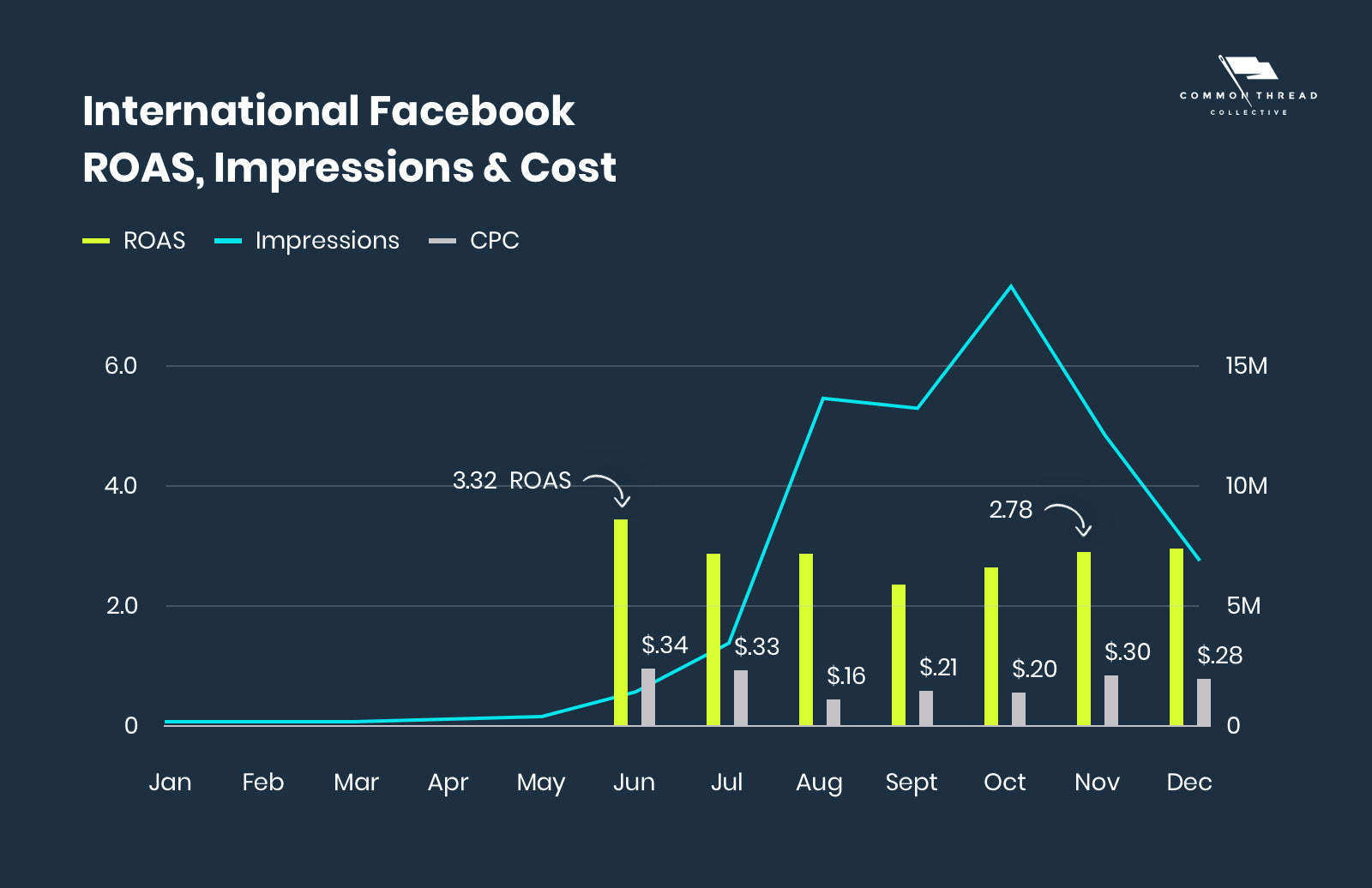
Today, it continues to push cross-border sales through consolidated campaigns where creative testing takes place at the ad level:
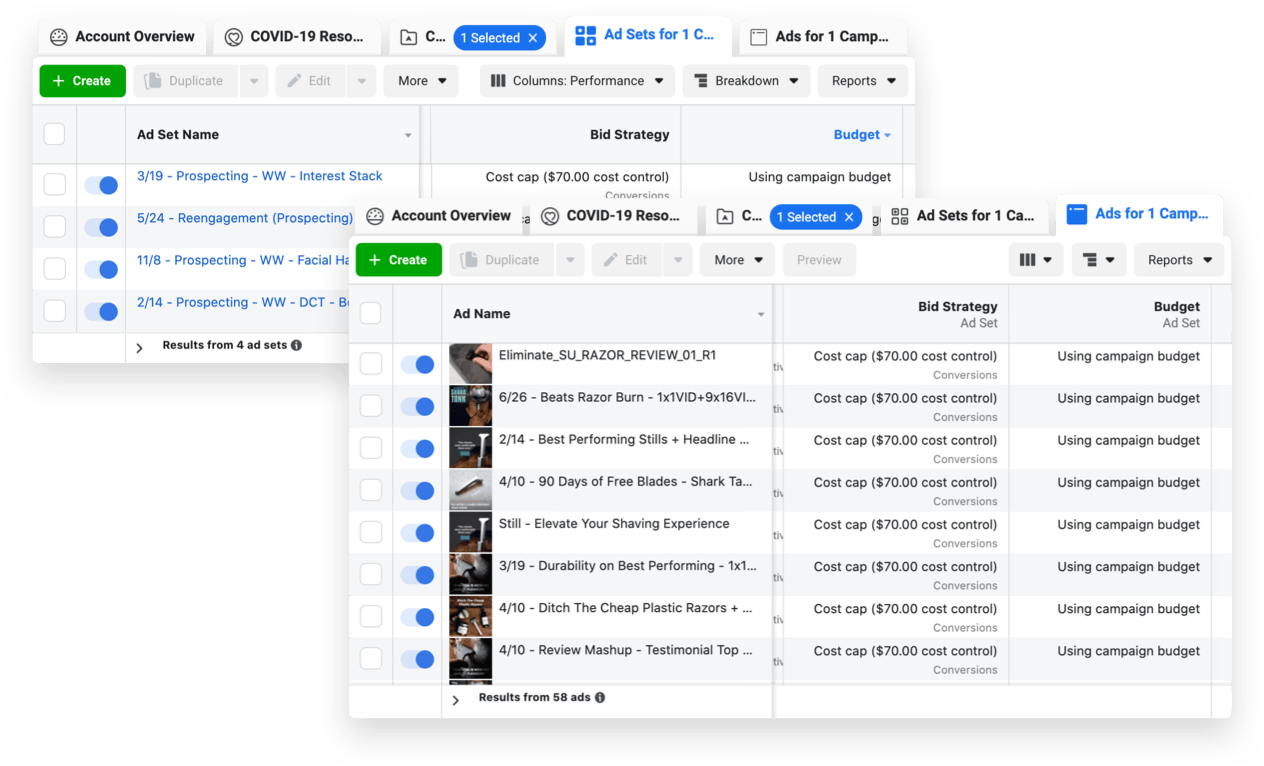
The first two ads below show Supply’s international use of (1) video UGC and (2) a real customer review. The third is from its ‘Shark Tank’ Prospecting campaign, which is limited to US audiences only:
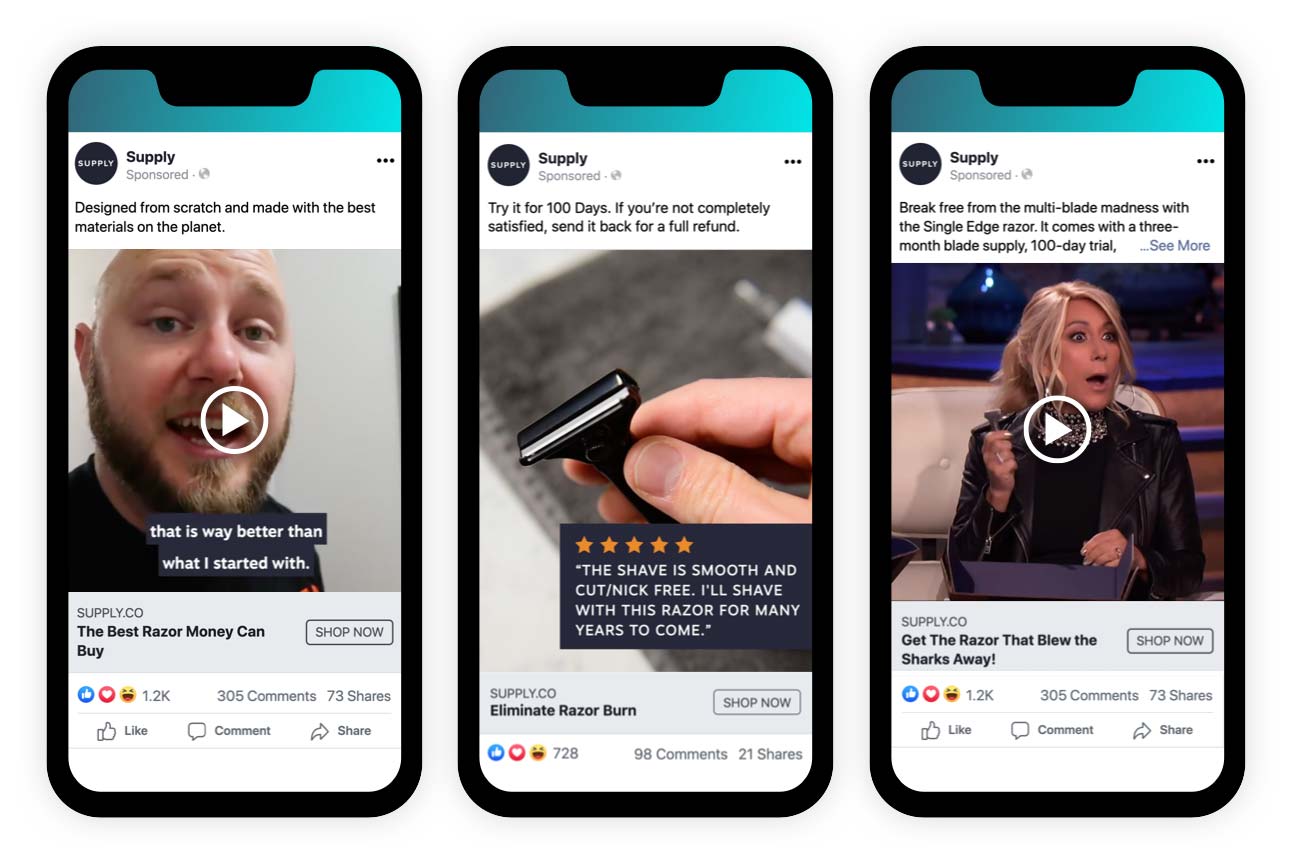
Going beyond language barriers is Native. While the majority of its ad account spends in English-speaking countries, it also separates campaigns by demographics (female versus male) as well as by language.
In this case, comparing ads from completely different campaigns — as well as completely different Facebook pages — brings the structure into focus:

5. Event Campaign: Western Rise
For the last campaign type, Black Friday, Cyber Monday rules the landscape. But because we’ve covered it extensively — particularly from the holiday offers and campaigns side — let’s close out our final example with a less obvious choice …
For Father’s Day this year, Western Rise ran one event-specific campaign for two time-sensitive bundles. Its ad sets were grouped by two Broad-match female audiences for gifting:

The first ad set leveraged heartfelt stills but (in the copy on both the ad and landing page) sold the sale. The second ad set leaned on an evergreen video highlighting the USP of the pants while iterating on playful copy:
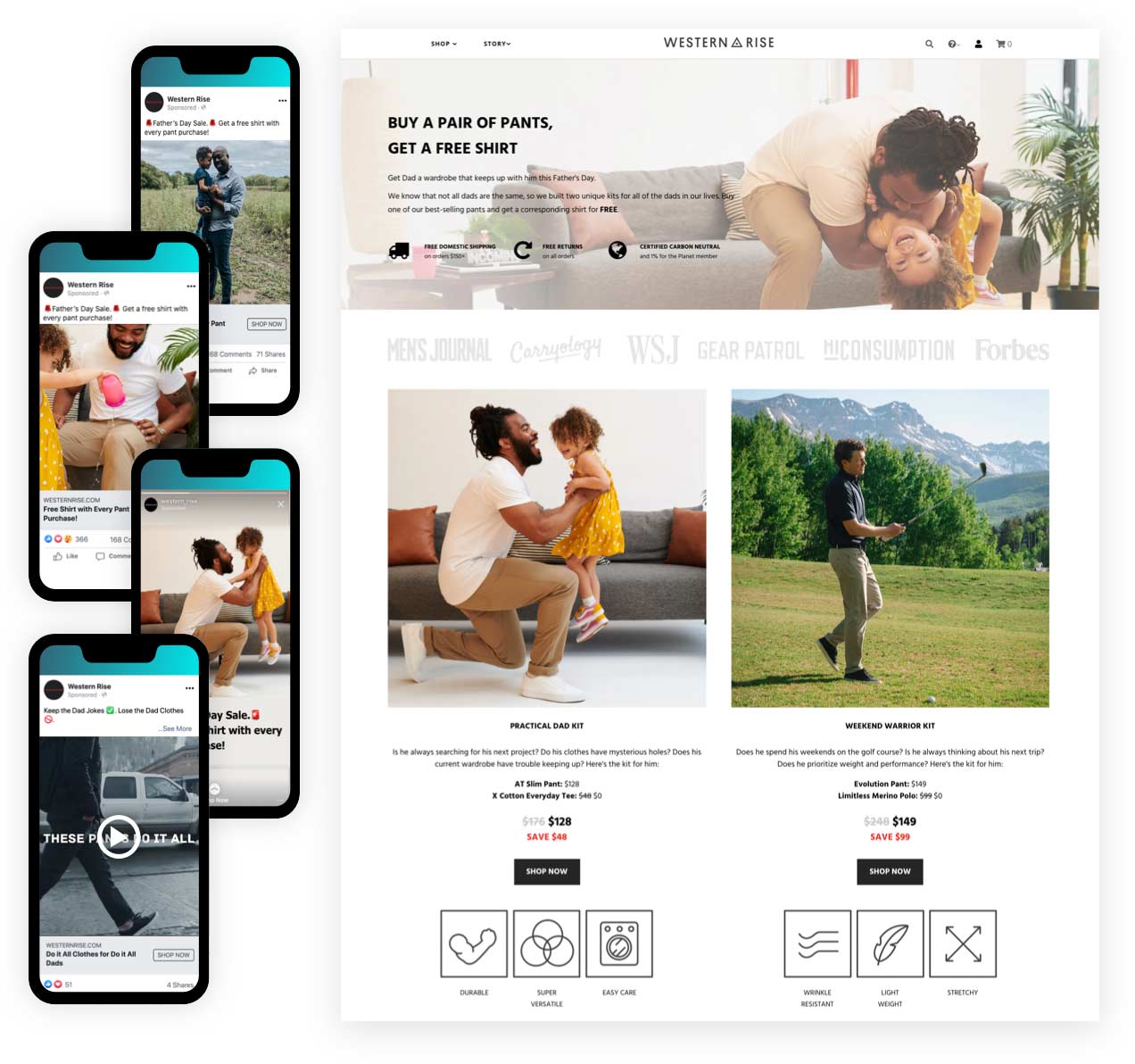

Both of the ads take the prospect through to a specific Father’s Day bundle page which highlights what the deal is and clearly articulates the brands USPs.
You can have a re-engagement campaign but make sure they are excluded from your prospecting and remarketing so they don’t get lumped in with those.
A Better Way to Structure Ecommerce Facebook Campaigns in Business Manager
Hopefully, this guide lived up to its two-fold promise at the start.
First, the least sexy exploration of Facebook advertising campaigns ever produced. Second, tangible, tactical, and — above all — step-by-step guidance on how you can regain your paid-media stability … and sanity.
If you have any questions, please drop them into the comments below.
If you’d like more ecommerce training on growing your business, then check out ADmission — Common Thread Collective’s membership community where there’s even more how-to content on the consolidated ad account structure.
Or, if you want to simply off-load your ad buying to a trusted partner … then start a conversation here.
Lastly, make sure you don’t leave without grabbing the heart and soul of this guide:

We won't send spam. Unsubscribe at any time.

Adrianne Austin is Growth Strategist at Common Thread Collective, where she helps some of the most-recognized DTC brands scale profitably. She’s also “mama to Valor boy,” an investor in Our Spare Change — a social enterprise creating jewelry out of high quality metals — and baked sourdough before the pandemic. If you’d like to connect, reach out to her on Twitter.

